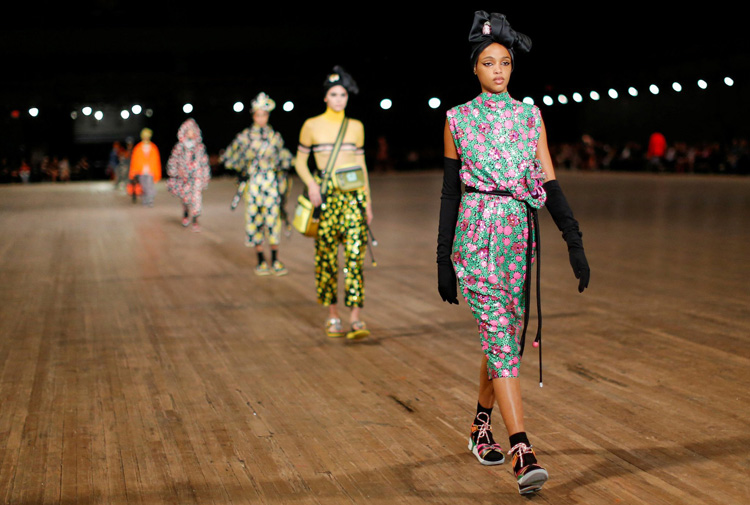The atmosphere was buzzing as Marc Jacobs presented his Spring Summer 2018 show in Park Avenue Armory, an event also marking 25 years since the beginning of his solo career. Digging deep in the archives to celebrate a quarter century which first began with his Spring Summer 1993 collection, past seasons were reworked, and momentous moments referenced. From sixties dresses to flower power prints, straight boas from the 80s, retro overalls, futuristic flip flops and turbans to mirror Kate Moss’ iconic look at the 2009 Met Gala, it was a saturated collection making Marc Jacobs the king of creative opulence.

In the last 25 years, Jacobs first shaped the style in the 90’s, starting with his ‘grunge collection’, before presenting creations that would reflect his own vision about society, with his ability to predict trends and stage high-concept catwalk shows impressing the fashion industry. But his infectious sense of fun and daring style, kilts, skirts and even dresses have all featured in his wardrobe, has also endeared a legion of followers.
Born in New York City on April 9, 1963, Jacobs’ first foray into fashion was being taught to knit by his grandmother in her Manhattan apartment. He progressed to working at hip boutique Charivari where he first met Perry Ellis, the designer who encouraged him to enrol at Parsons the New School for Design and later take him on as creative director of his label. When Jacobs graduated in 1984, as Design Student of the Year, no less, he caught the eye of business executive Robert Duffy, beginning a business partnership that would last into the present day. However, his stellar trajectory hasn’t been without the odd hiccup. Jacobs’ contract with Perry Ellis was terminated in 1993, after management were disgruntled by his grunge-inspired collection, a show that is today credited with recasting the mood of fashion for that decade. The hurt was promptly assuaged, however, when he was awarded Womenswear Designer of the Year by the Council of Fashion Designers of America the same year, an honour he has received five times throughout his career, together with many other accolades.

“ONE THING THAT IS EXCITING ABOUT FASHION IS THE SURPRISE ELEMENT. PEOPLE DON’T KNOW WHAT THEY WANT. THEY JUST KNOW WHEN THEY SEE IT.”- Marc Jacobs
Joining Louis Vuitton in 1997, at the beginning of a period of rapid growth in the luxury sector, Jacobs was responsible for introducing Vuitton’s ready-to-wear line, turning the brand into a global powerhouse. Prior to his tenure, the label was known only for its leather goods and luggage line. He also launched the first of the fashion house’s art collaborations, working with artists such as Stephen Sprouse, Richard Prince, Takashi Murakami, and Yayoi Kusama.
His tenure at Vuitton became one of the most successful revivals of a historic French house, and the longest-running, apart from Karl Lagerfeld at Chanel and Fendi, spawning what has become a standard business model to place contemporary designers at fashion labels. While Vuitton’s ready-to-wear has become a substantial business, its accessories have been the most important money makers for LVMH. Remember the Stephen Sprouse Louis Vuitton graffiti bags from 2001? The smiley-cherry Vuitton bags designed with Takashi Murakami in 2003? Or the Sprouse animal-print scarf phenomenon? Those intentionally defaced handbags were both a metaphor for Jacobs’s irreverent approach to stuffy French fashion, and also among the most successful in the history of the company. Although a risky move, they re-established the label as a luxury powerhouse and lead to an international craze for Louis Vuitton bags.

Closing his chapter at the French Maison and beginning a new journey with his eponymous brand, Jacobs presented his final Louis Vuitton show for Spring Summer 2014, a celebration of his greatest hits, created entirely in black, as was his first show for the label. The staging of the show re-created many of the sets from his sixteen-year tenure, the elevators, the escalators, the carousel, the fountain, the previous season’s hotel corridors, they were all there, a reminder of the designer’s extraordinary showmanship, only rendered this time in shades of black.
Marc Jacobs is a powerful fashion force, but he is known for being down-to-earth and speaking his mind, no matter what is on it. His achievements speak for themselves. His directional Marc Jacobs catwalk collection, launched in 1994, with bags in 2000, remains a kooky-cool high point of New York fashion week, while the newly expanded Marc Jacobs brand now combines the original diffusion lines for clarity. The spin-off perfumes are bestsellers, together with a recently launched make-up collection, and his work for Louis Vuitton, where he joined as the wilfully controversial creative director in 1997, is also consistently era-defining.
By Eliza Scarborough
READ MORE















